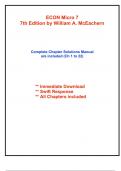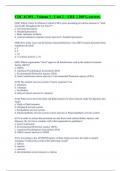ECON Micro 7
7th Edition by William A. McEachern
Complete Chapter Solutions Manual
are included (Ch 1 to 22)
** Immediate Download
** Swift Response
** All Chapters included
,Instructor Manual
William McEachern and Veronika Dolar, ECON Micro, 7e, 2025, 9780357902004; Chapter 1:
The Art and Science of Economic Analysis
TABLE OF CONTENTS
Purpose and Perspective of the Chapter ................................................................................................... 2
Chapter Objectives ..................................................................................................................................... 2
Key Terms ................................................................................................................................................... 2
Chapter Outline .......................................................................................................................................... 5
Answers to End of Chapter Questions .................................................................................................... 10
,PURPOSE AND PERSPECTIVE OF THE CHAPTER
This chapter has two purposes: to introduce students to some of the basic language of economics and to
stimulate student interest in the subject. It conveys to students that economics not only is found on
financial news websites, but also is very much a part of their everyday lives. Beginning with the
economic problem of scarce resources but unlimited wants, this chapter provides an overview of the field
and the analytical techniques used. Concepts introduced include resources, goods and services, the
economic decision makers in the economy, and marginal analysis. Two models for analysis, the circular
flow model and steps of the scientific method, are introduced. The appendix introduces the use of graphs.
CHAPTER OBJECTIVES
The following objectives are addressed in this chapter:
1.1 Explain how scarcity drives economic decision-making for individuals, businesses, and
governments.
1.2 Contrast macroeconomic concepts versus microeconomic concepts.
1.3 Explain the importance of the other things constant (ceteris paribus) assumption in economic
theory and models.
1.4 Distinguish between positive and normative economic analysis.
1.5 Using the circular flow model, illustrate how real-world economic transactions and interactions
are represented within the model.
1.6 Identify pitfalls of economic analysis in real-life instances such as the fallacy of association-is-
causation, the fallacy of composition, and the mistake of disregarding secondary effects.
[return to top]
KEY TERMS
Scarcity: A condition that arises from the conflict between unlimited human wants and the limited
resources available to fulfill those wants.
Economics: A social science that studies how individuals, businesses, governments, and societies allocate
scarce resources to satisfy unlimited wants and needs.
Microeconomics: The study of the economic behavior in individual markets, industries, or sectors, such
as that for computers or unskilled labor.
, Macroeconomics: The study of the economic behavior of entire economies, as measured, for example, by
total production and employment.
Economic theory or economic model: A simplification of reality used to make conjectures about cause
and effect in the real world.
Scientific method: A systematic approach scientists use to study and understand the world through
observation, hypothesis formulation, experimentation, data analysis, and conclusion drawing.
Variable: A measure or a quantity that can take on different values or levels and is used to represent
economic concepts or phenomena.
Other-things-constant assumption: The assumption, when focusing on the relation among key
economic variables, that other variables remain unchanged; in Latin, ceteris paribus.
Behavioral assumptions: An assumption that describes the expected behavior of economic decision
makers—what motivates them.
Hypothesis: A theory about how key variables relate.
Positive economic statement: A statement that can be proved or disproved by reference to facts.
Normative economic statement: A statement that reflects an opinion, which cannot be proved or
disproved by reference to the facts.
Circular flow model: A diagram that traces the flow of resources, products, income, and revenue among
economic decision makers.
Resources: The inputs, or factors of production, used to produce the goods and services that people want;
consists of labor, capital, human capital, and material resources.
Labor: The physical and mental effort used to produce goods and services.
Capital: The buildings, equipment, tools, utensils, appliances, and machinery used to produce goods and
services.
Human capital: The knowledge, skills, abilities, and other attributes that individuals possess, which can
be used to produce goods and services and generate economic value.
Entrepreneurial ability: The imagination required to develop a new product or process, the skill needed
to organize production, and the willingness to take the risk of profit or loss.
Entrepreneur: A profit-seeking decision maker who starts with an idea, organizes an enterprise to bring
that idea to life, and assumes the risk of the operation.
Natural resources: All gifts of nature used to produce goods and services; includes renewable and
exhaustible resources.





